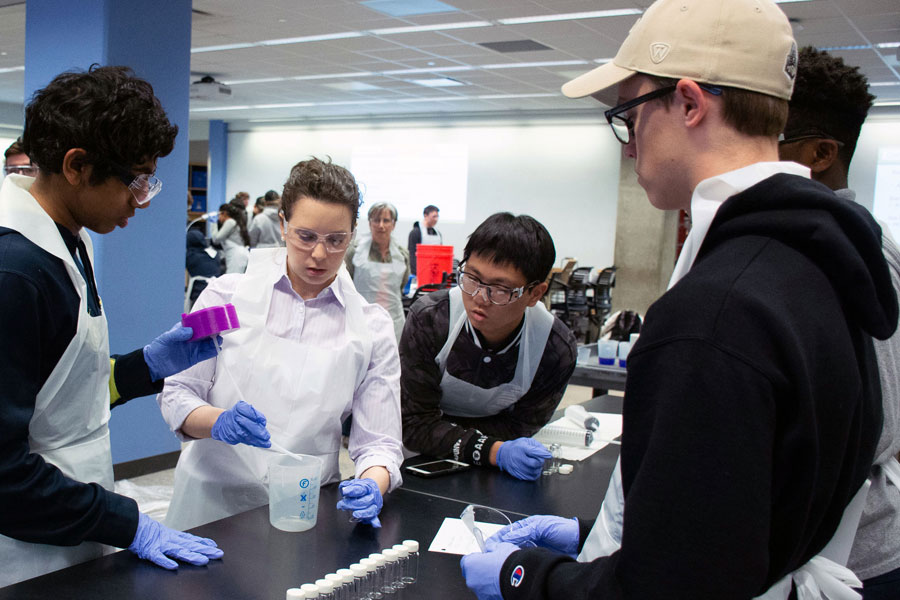Adding cyber-assisted and interactive learning boosts chemical engineering students’ motivation and success, study shows
 Allison Godwin (center), who co-authored a paper showing benefits of redesigning a sophomore chemical engineering course, works with students to conduct an experiment in a first-year chemical engineering class. (Photo was taken pre-COVID-19.)
Allison Godwin (center), who co-authored a paper showing benefits of redesigning a sophomore chemical engineering course, works with students to conduct an experiment in a first-year chemical engineering class. (Photo was taken pre-COVID-19.)
But a newly published study by two Purdue College of Engineering professors demonstrates that this trend can be reversed, relatively simply. The research shows that redesigning a course to add cyber-assisted and active, collaborative learning can build students’ motivation, confidence, and persistence – significantly boosting academic success.
Allison Godwin, associate professor of engineering education and, by courtesy, chemical engineering, CISTAR Workforce Development Co-Director; and Bryan Boudouris, professor of chemical engineering, reported their findings in a paper featured in the summer issue of Chemical Engineering Education.
“This is a great example of engineering education research applied in practice at Purdue,” says Alina Alexeenko, associate dean for undergraduate education, and professor of aeronautics and astronautics and chemical engineering.
Drawing on Godwin’s experience in chemical engineering and engineering education, as well as Boudouris’ background in chemical engineering, they modified the structure and emphasis of an introductory sophomore course they co-taught – CHE20500: Chemical Engineering Calculations. “The results we have achieved would not have been possible without Professor Godwin’s experience as a chemical engineer and perspective from her training and leadership in engineering education research,” Boudouris says.
The study compared student outcomes in Spring 2018, before the redesign took effect, and Spring 2019, when it was implemented. Students who took the updated course generally felt more optimistic about their capabilities. In addition, the rate at which students failed or withdrew from the course decreased from approximately 27 percent before the redesign to about 16 percent after the restructuring.
“An important point for faculty is that they don’t necessarily have to change the majority of what they teach,” Godwin says. “Rather, changing how they teach it can make a substantial difference for students. We found that delivering basic content in short online videos watched before class, as well as using team-based problem solving to help students apply knowledge in class, can effectively supplement lecturing – producing lasting dividends for students.”
“For me, the big takeaway is we leveraged technology to make more meaningful use of class time in a manner not often seen in chemical engineering programs across the nation,” Boudouris says. “The redesign created time and space for students to struggle with complex concepts and solve problems with their peers, also receiving faculty guidance, during class. Students who otherwise might have become discouraged saw they weren’t alone. They learned to overcome challenges collaboratively, which increased their confidence, leading to higher grades.”
The research is continuing, to monitor long-range effects of the course restructuring on students’ motivation, academic performance, and progression through chemical engineering.
Potential benefits of the research extend throughout chemical engineering and to other engineering disciplines, both within and beyond Purdue. “The core concepts of the redesign could easily be replicated in other engineering areas and at other colleges and universities,” Godwin says.
In one vehicle for spreading the impact, the researchers are collaborating on a National Science Foundation-backed Mechanical Engineering Education Research Center at Purdue (MEERCat) Purdue project to drive innovations in engineering education, aimed at bolstering student success and retention. The multi-university initiative is applying the success of Freeform – an active, blended, collaborative learning environment developed at Purdue – to additional disciplines and courses, including CHE20500.
“We’re really excited about participating in the MEERCat project,” Godwin says. “Because most chemical engineering programs in the United States teach essentially the same course that we redesigned, colleges and universities around the country will be able to adopt the supplementary resources and interactive learning methods we’ve created.”
Full article: Fostering Motivation for Chemical Engineering Students’ Academic Success: An Example from a Sophomore Materials and Energy Balances Course (Chemical Engineering Education journal)
